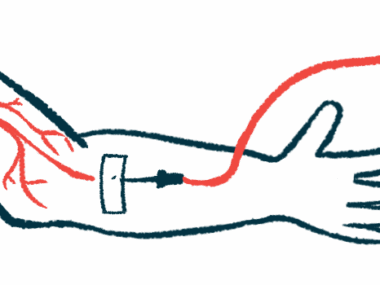Tavneos found safe, effective for AAV patients in real-world study
But close monitoring 'crucial' for potential side effects, per researchers
Written by |

Adding Tavneos (avacopan) to standard maintenance treatment safely and effectively promotes disease remission in ANCA-associated vasculitis (AAV) patients, according to a real-world study involving five German centers.
In fact, remission rates after one year of Tavneos treatment were higher than those reported in the Phase 3 ADVOCATE trial (NCT02994927) that had supported the therapy’s approval. In the real world, the remission rate was slightly higher than 90% at the one-year mark versus about 65% after 12 months in the clinical trial.
Higher remission rates also were found in patient subgroups excluded from the Phase 3 study, including among individuals with severe kidney disease and/or lung bleeding.
Still, adverse events were the cause of Tavneos discontinuation in 21% of cases, data from the new study showed.
As such, these findings overall highlight that Tavneos “provides an effective and relatively safe therapy … though vigilant monitoring for potential side effects is crucial,” the researchers wrote.
Titled “Avacopan in Anti-Neutrophil Cytoplasmic Autoantibodies-Associated Vasculitis in a Real-World Setting,” the study was published in the journal Kidney International Reports in the form of a research letter.
Investigating the use of Tavneos in the real world
AAV is an autoimmune disease marked by inflammation and damage to small blood vessels, affecting several organs such as the kidneys and lungs. Most AAV cases are caused by the presence of self-reactive antibodies, called ANCAs, that ultimately result in the activation of the complement cascade, a part of the immune system.
Tavneos is approved as an add-on to standard therapies, including glucocorticoids, in adults with microscopic polyangiitis (MPA) and granulomatosis with polyangiitis (GPA), the two most common AAV types. Taken twice daily in the form of oral capsules, it works to suppress complement cascade activation.
ADVOCATE data showed Tavneos was better than the glucocorticoid prednisone at promoting long-term remission and improving kidney function in AAV patients. It also helped reduce the need for glucocorticoids, whose long-term use is associated with serious side effects.
However, there is limited data on the use of Tavneos in the real-world setting, outside of clinical trials that usually involve restrictive eligibility criteria.
To learn more, a team of researchers in Germany analyzed data from 39 adults with either newly diagnosed or relapsing GPA or MPA. All were treated with Tavneos for at least three months between February 2022 and June 2023 at five German centers.
The 21 men and 18 women involved in the study had a mean age of 64. Most (85%) had kidney involvement, and at diagnosis, 38% had kidney failure, as indicated by a mean estimated glomerular filtration rate (eGFR) below 15 mL/min. Seven of these patients needed dialysis to replace kidney function.
Also, seven patients (18%) had diffuse alveolar hemorrhage (DAH) — bleeding caused by damage to the blood vessels surrounding the tiny air sacs where gases are exchanged — with two of them requiring invasive ventilation. The researchers noted that the effects of Tavneos in this subgroup of patients have not been reported before.
The most commonly used therapy to induce disease remission was rituximab (sold as Rituxan, among others), given to 62% of patients. Cyclophosphamide (sold as Cytoxan, among others) was used to treat the remaining 38% of patients.
Over 90% of patients achieved disease remission at one-year mark
Tavneos was used in all patients to maintain disease remission, together with prednisolone, a glucocorticoid, in 95% of cases, and rituximab in 78%.
The main reason for prescribing Tavneos was to reduce the glucocorticoid dose (77%), followed by improving kidney response (59%) and overall treatment outcomes (54%). The need to intensify treatment to better control symptoms or relapses was the reason cited for the therapy’s use in 51% of cases.
Patients were followed up for a mean period of 41 weeks, or about 10 months. Disease remission was defined by a score of 0 in the Birmingham Vasculitis Activity Score (BVAS) and a daily prednisolone dose up to 7.5 mg.
Nearly 9 in 10 (87.5%) achieved disease remission at six months and showed sustained remission at one year (91%). High remission rates also were observed among the subgroup of patients with kidney failure (92% and 89%) and DAH (83% and 100%).
In all patients, including the two subgroups, Tavneos treatment was associated with a rapid reduction in ANCA levels and BVAS scores, as well as an increase in mean eGFR, indicating less severe disease and better kidney function. Also, there was a gradual reduction in mean prednisolone equivalent dose.
Our data suggest that [Tavneos] remains both safe and effective when combined with maintenance therapy, and its use in real-life setting does not result in foregoing maintenance treatment. … Additional research is required to determine the optimal treatment duration and [to] understand the long-term effects of [Tavneos] treatment.
A total of four patients experienced a major disease relapse, requiring intensification of immunosuppressive therapies, at a mean of 4.7 months after initiating Tavneos.
Tavneos was discontinued in nine patients (23%), and in eight of them, this was due to adverse events.
About a third of all patients (36%) experienced at least one severe adverse event. Also, 62% experienced potential glucocorticoid-related adverse events. Infections were more frequent and severe in patients with kidney failure.
“Our data suggest that [Tavneos] remains both safe and effective when combined with maintenance therapy, and its use in real-life setting does not result in foregoing maintenance treatment,” the researchers wrote.
“Additional research is required to determine the optimal treatment duration and [to] understand the long-term effects of [Tavneos] treatment,” the team added.







